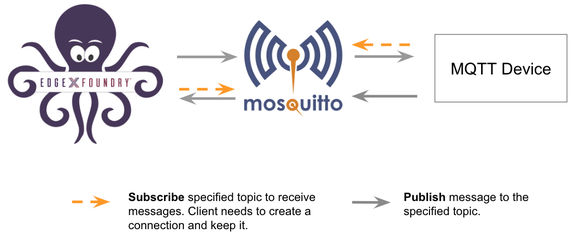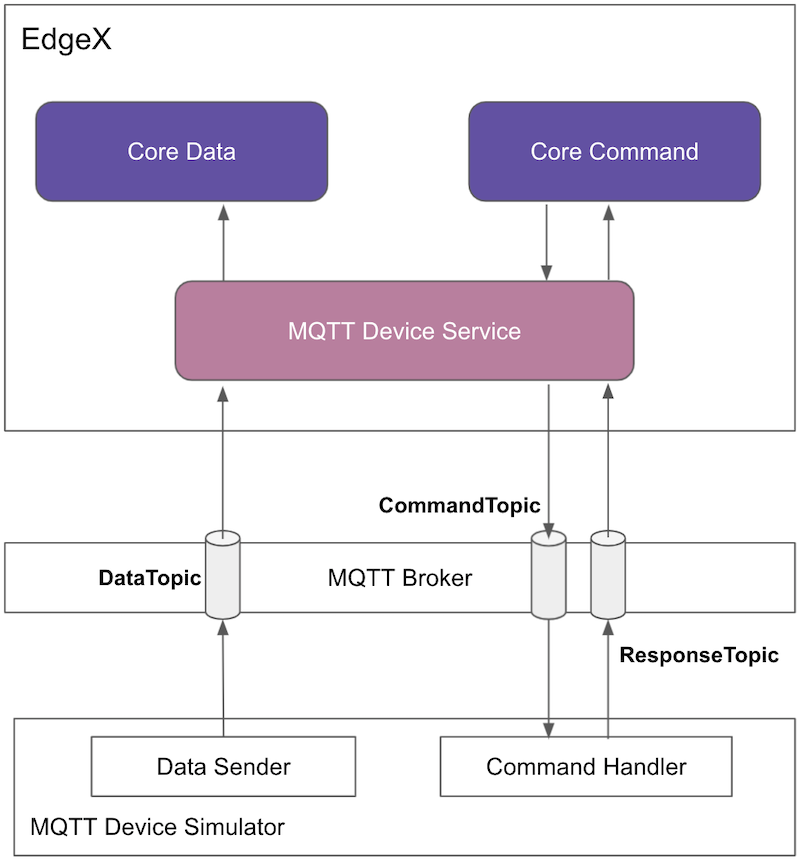MQTT
EdgeX - Levski Release
Overview
In this example, we use a script to simulate a custom-defined MQTT device, instead of a real device. This provides a straight-forward way to test the device-mqtt features using an MQTT-broker.

Note
Multi-Level Topics move metadata (i.e. device name, command name,... etc) from the payload into the MQTT topics. Notice the sections marked with Using Multi-level Topic: for relevant input/output throughout this example.
Prepare the Custom Device Configuration
In this section, we create folders that contain files required for deployment of a customized device configuration to work with the existing device service:
- custom-config
|- devices
|- my.custom.device.config.yaml
|- profiles
|- my.custom.device.profile.yml
Device Configuration
Use this configuration file to define devices and schedule jobs. device-mqtt generates a relative instance on start-up.
Create the device configuration file, named my.custom.device.config.yaml, as shown below:
# Pre-define Devices
deviceList:
name: "my-custom-device"
profileName: "my-custom-device-profile"
description: "MQTT device is created for test purpose"
labels:
- "MQTT"
- "test"
protocols:
mqtt:
CommandTopic: "command/my-custom-device"
autoEvents:
interval: "30s"
onChange: false
sourceName: "message"
Note
CommandTopic is used to publish the GET or SET command request
Device Profile
The DeviceProfile defines the device's values and operation method, which can be Read or Write.
Create a device profile, named my.custom.device.profile.yml, with the
following content:
name: "my-custom-device-profile"
manufacturer: "iot"
model: "MQTT-DEVICE"
description: "Test device profile"
labels:
- "mqtt"
- "test"
deviceResources:
-
name: randnum
isHidden: true
description: "device random number"
properties:
valueType: "Float32"
readWrite: "R"
-
name: ping
isHidden: true
description: "device awake"
properties:
valueType: "String"
readWrite: "R"
-
name: message
isHidden: false
description: "device message"
properties:
valueType: "String"
readWrite: "RW"
-
name: json
isHidden: false
description: "JSON message"
properties:
valueType: "Object"
readWrite: "RW"
mediaType: "application/json"
deviceCommands:
-
name: values
readWrite: "R"
isHidden: false
resourceOperations:
- { deviceResource: "randnum" }
- { deviceResource: "ping" }
- { deviceResource: "message" }
Prepare docker-compose file
- Clone edgex-compose
!!! note Use main branch until levski is released.
$ git clone git@github.com:edgexfoundry/edgex-compose.git $ cd edgex-compose $ git checkout main - Generate the docker-compose.yml file (notice this includes mqtt-broker)
$ cd compose-builder $ make gen ds-mqtt mqtt-broker no-secty ui - Check the generated file
$ ls | grep 'docker-compose.yml' docker-compose.yml
Mount the custom-config
Create a docker-compose file docker-compose.override.yml to extend the compose file which generated by the compose-builder. In this file, we add volume path and environment variables as shown below:
# docker-compose.override.yml
version: '3.7'
services:
device-mqtt:
environment:
DEVICE_DEVICESDIR: /custom-config/devices
DEVICE_PROFILESDIR: /custom-config/profiles
volumes:
- /path/to/custom-config:/custom-config
Note
Replace the /path/to/custom-config in the example with the correct path
Start EdgeX Foundry on Docker
Deploy EdgeX using the following commands:
$ cd edgex-compose/compose-builder
$ docker compose pull
$ docker compose -f docker-compose.yml -f docker-compose.override.yml up -d
Using a MQTT Device Simulator
Overview

Expected Behaviors
Using the detailed script below as a simulator, there are three behaviors:
- Publish random number data every 15 seconds.
The simulator publishes the data to the MQTT broker with topic incoming/data/my-custom-device/values and the message is similar to the following:
{
"randnum" : 4161.3549,
"ping" : "pong",
"message" : "Hello World"
}
-
Receive the reading request, then return the response.
-
The simulator receives the request from the MQTT broker, the topic is
command/my-custom-device/randnum/get/293d7a00-66e1-4374-ace0-07520103c95fand message returned is similar to the following:{"randnum":"42.0"} -
The simulator returns the response to the MQTT broker, the topic is
command/response/#and the message is similar to the following:{"randnum":"4.20e+01"}
-
-
Receive the set request, then change the device value.
-
The simulator receives the request from the MQTT broker, the topic is
command/my-custom-device/testmessage/set/293d7a00-66e1-4374-ace0-07520103c95fand the message is similar to the following:{"message":"test message..."} -
The simulator changes the device value and returns the response to the MQTT broker, the topic is
command/response/#and the message is similar to the following:{"message":"test message..."}
-
Creating and Running a MQTT Device Simulator
To implement the simulated custom-defined MQTT device, create a javascript, named mock-device.js, with the following content:
function getRandomFloat(min, max) {
return Math.random() * (max - min) + min;
}
const deviceName = "my-custom-device";
let message = "test-message";
let json = {"name" : "My JSON"};
// DataSender sends async value to MQTT broker every 15 seconds
schedule('*/15 * * * * *', ()=>{
var data = {};
data.randnum = getRandomFloat(25,29).toFixed(1);
data.ping = "pong"
data.message = "Hello World"
publish( 'incoming/data/my-custom-device/values', JSON.stringify(data));
});
// CommandHandler receives commands and sends response to MQTT broker
// 1. Receive the reading request, then return the response
// 2. Receive the set request, then change the device value
subscribe( "command/my-custom-device/#" , (topic, val) => {
const words = topic.split('/');
var cmd = words[2];
var method = words[3];
var uuid = words[4];
var response = {};
var data = val;
if (method == "set") {
switch(cmd) {
case "message":
message = data[cmd];
break;
case "json":
json = data[cmd];
break;
}
}else{
switch(cmd) {
case "ping":
response.ping = "pong";
break;
case "message":
response.message = message;
break;
case "randnum":
response.randnum = 12.123;
break;
case "json":
response.json = json;
break;
}
}
var sendTopic ="command/response/"+ uuid;
publish( sendTopic, JSON.stringify(response));
});
$ mv mock-device.js /path/to/mqtt-scripts
$ docker run --rm --name=mqtt-scripts \
-v /path/to/mqtt-scripts:/scripts --network host \
dersimn/mqtt-scripts --dir /scripts
Note
Replace the /path/to/mqtt-scripts in the example mv command with the correct path
Then the mqtt-scripts show logs as below:
2022-08-12 09:52:42.086 <info> mqtt-scripts 1.2.2 starting
2022-08-12 09:52:42.227 <info> mqtt connected mqtt://127.0.0.1
2022-08-12 09:52:42.733 <info> /scripts/mock-device.js loading
Execute Commands
Now we're ready to run some commands.
Find Executable Commands
Use the following query to find executable commands:
$ curl http://localhost:59882/api/v3/device/all | json_pp
{
"deviceCoreCommands" : [
{
"profileName" : "my-custom-device-profile",
"coreCommands" : [
{
"name" : "values",
"get" : true,
"path" : "/api/v3/device/name/my-custom-device/values",
"url" : "http://edgex-core-command:59882",
"parameters" : [
{
"resourceName" : "randnum",
"valueType" : "Float32"
},
{
"resourceName" : "ping",
"valueType" : "String"
},
{
"valueType" : "String",
"resourceName" : "message"
}
]
},
{
"url" : "http://edgex-core-command:59882",
"parameters" : [
{
"resourceName" : "message",
"valueType" : "String"
}
],
"name" : "message",
"get" : true,
"path" : "/api/v3/device/name/my-custom-device/message",
"set" : true
},
{
"name": "json",
"get": true,
"set": true,
"path": "/api/v3/device/name/MQTT-test-device/json",
"url" : "http://edgex-core-command:59882",
"parameters": [
{
"resourceName": "json",
"valueType": "Object"
}
]
}
],
"deviceName" : "my-custom-device"
}
],
"apiVersion" : "v2",
"statusCode" : 200
}
Execute SET Command
Execute a SET command according to the url and parameterNames, replacing [host] with the server IP when running the SET command.
$ curl http://localhost:59882/api/v3/device/name/my-custom-device/message \
-H "Content-Type:application/json" -X PUT \
-d '{"message":"Hello!"}'
Execute GET Command
Execute a GET command as follows:
$ curl http://localhost:59882/api/v3/device/name/my-custom-device/message | json_pp
{
"apiVersion":"v2",
"event":{
"apiVersion":"v2",
"deviceName":"my-custom-device",
"id":"13164041-2e6c-4454-9bc3-8e8987e85311",
"origin":1660298227470009014,
"profileName":"my-custom-device-profile",
"readings":[
{
"deviceName":"my-custom-device",
"id":"c58e65b4-62f0-4e41-b368-645993ec0bfd",
"origin":1660298227470005426,
"profileName":"my-custom-device-profile",
"resourceName":"message",
"value":"Hello!",
"valueType":"String"
}
],
"sourceName":"message"
},
"statusCode":200
}
Schedule Job
The schedule job is defined in the autoEvents section of the device definition file:
autoEvents:
Interval: "30s"
OnChange: false
SourceName: "message"
After the service starts, query core-data's reading API. The results show that the service auto-executes the command every 30 secs, as shown below:
$ curl http://localhost:59880/api/v3/reading/resourceName/message | json_pp
{
"statusCode" : 200,
"readings" : [
{
"value" : "test-message",
"id" : "e91b8ca6-c5c4-4509-bb61-bd4b09fe835c",
"resourceName" : "message",
"origin" : 1624418361324331392,
"profileName" : "my-custom-device-profile",
"deviceName" : "my-custom-device",
"valueType" : "String"
},
{
"resourceName" : "message",
"value" : "test-message",
"id" : "1da58cb7-2bf4-47f0-bbb8-9519797149a2",
"deviceName" : "my-custom-device",
"valueType" : "String",
"profileName" : "my-custom-device-profile",
"origin" : 1624418330822988843
},
...
],
"apiVersion" : "v2"
}
Async Device Reading
The device-mqtt subscribes to a DataTopic, which waits for the real device to send value to MQTT broker, then device-mqttparses the value and forward to the northbound.
The data format contains the following values:
- name = device name
- cmd = deviceResource name
- method = get or set
- cmd = device reading
The following results show that the mock device sent the reading every 15 secs:
$ curl http://localhost:59880/api/v3/reading/resourceName/randnum | json_pp
{
"readings" : [
{
"origin" : 1624418475007110946,
"valueType" : "Float32",
"deviceName" : "my-custom-device",
"id" : "9b3d337e-8a8a-4a6c-8018-b4908b57abb8",
"resourceName" : "randnum",
"profileName" : "my-custom-device-profile",
"value" : "2.630000e+01"
},
{
"deviceName" : "my-custom-device",
"valueType" : "Float32",
"id" : "06918cbb-ada0-4752-8877-0ef8488620f6",
"origin" : 1624418460007833720,
"profileName" : "my-custom-device-profile",
"value" : "2.570000e+01",
"resourceName" : "randnum",
},
...
],
"statusCode" : 200,
"apiVersion" : "v2"
}
MQTT Device Service Configuration
MQTT Device Service has the following configurations to implement the MQTT protocol.
| Configuration | Default Value | Description |
|---|---|---|
| MQTTBrokerInfo.Schema | tcp | The URL schema |
| MQTTBrokerInfo.Host | localhost | The URL host |
| MQTTBrokerInfo.Port | 1883 | The URL port |
| MQTTBrokerInfo.Qos | 0 | Quality of Service 0 (At most once), 1 (At least once) or 2 (Exactly once) |
| MQTTBrokerInfo.KeepAlive | 3600 | Seconds between client ping when no active data flowing to avoid client being disconnected. Must be greater then 2 |
| MQTTBrokerInfo.ClientId | device-mqtt | ClientId to connect to the broker with |
| MQTTBrokerInfo.CredentialsRetryTime | 120 | The retry times to get the credential |
| MQTTBrokerInfo.CredentialsRetryWait | 1 | The wait time(seconds) when retry to get the credential |
| MQTTBrokerInfo.ConnEstablishingRetry | 10 | The retry times to establish the MQTT connection |
| MQTTBrokerInfo.ConnRetryWaitTime | 5 | The wait time(seconds) when retry to establish the MQTT connection |
| MQTTBrokerInfo.AuthMode | none | Indicates what to use when connecting to the broker. Must be one of "none" , "usernamepassword" |
| MQTTBrokerInfo.CredentialsPath | credentials | Name of the path in secret provider to retrieve your secrets. Must be non-blank. |
| MQTTBrokerInfo.IncomingTopic | DataTopic (incoming/data/#) | IncomingTopic is used to receive the async value |
| MQTTBrokerInfo.ResponseTopic | ResponseTopic (command/response/#) | ResponseTopic is used to receive the command response from the device |
| MQTTBrokerInfo.UseTopicLevels | false (true) | Boolean setting to use multi-level topics |
| MQTTBrokerInfo.Writable.ResponseFetchInterval | 500 | ResponseFetchInterval specifies the retry interval(milliseconds) to fetch the command response from the MQTT broker |
Note
Using Multi-level Topic: Remember to change the defaults in parentheses in the table above.
Overriding with Environment Variables
The user can override any of the above configurations using environment: variables to meet their requirement, for example:
# docker-compose.override.yml
version: '3.7'
services:
device-mqtt:
environment:
MQTTBROKERINFO_CLIENTID: "my-device-mqtt"
MQTTBROKERINFO_CONNRETRYWAITTIME: "10"
MQTTBROKERINFO_USETOPICLEVELS: "false"